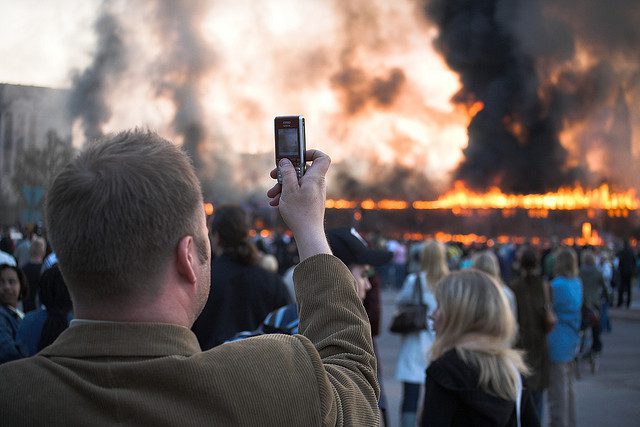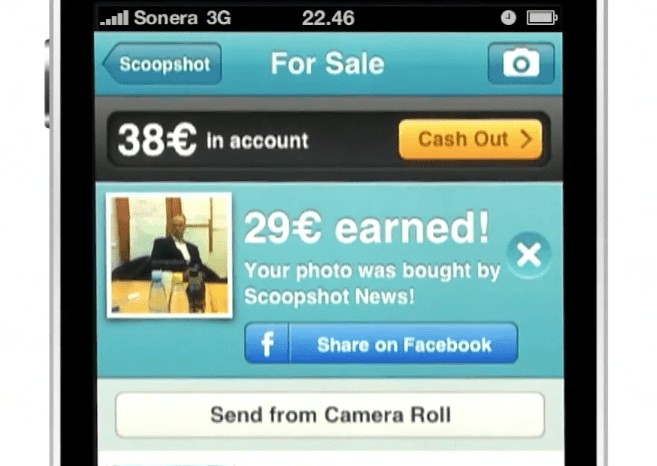
Mobile citizen photojournalism intermediary start-up Scoopshot is closing out a funding round to finance global expansion, claiming it could have spotted fake images that circulated of super-storm Sandy.
Formed in Finland late 2010 by Petri Rajha and tested mostly in Scandinavia until recently, the service is a mobile app through which users offer their photos for sale and through which media organisations can post paid photo assignments for users.
User submissions typically sell for around €17 ($22) whilst media entities typically set prices of €10 to €20 for “tasks”; Scoopshot takes a 30 percent cut.
CEO Niko Ruokosuo, an ex LA Times journalist, tells paidContent the service includes authentication that could help news publishers identify fake pictures:
“It works by having control of the image. When the image is captured with Scoopshot it is sent to us and no longer resides on the originating camera. It is impossible to edit those photos and that same exact file exists nowhere else, we guarantee that.
“Second, we know the exact GPS location and time where that photo was taken. It adds a level of security. We know the sender.”
These techniques aren’t necessarily fool-proof — not least because, as #FakeSandy showed, few such images typically come through formalised citizen-news services as much as they do through an array of social accounts and blogs.
“I wouldn’t trust a robot to do the job,” Stephen Sidlo, a breaking news picture editor for rival UGC service Demotix, which was acquired by Corbis this month, tells paidContent.
“Research on UGC verification manually is necessary, the rest can be manipulated.”
Likewise, Associated Press recently named Fergus Bell its social media and UGC editor after he constructed a similar human verification process for UGC atop the AP’s existing checks and balances.
“We can’t verify something unless we speak to the person that created it, in most cases,” Bell told Poynter last week. “When it comes to UGC, we only put stuff out when we can confirm it.”
 Even the humans on social networks themselves seemed to do a good job of debunking fake Sandy images.
Even the humans on social networks themselves seemed to do a good job of debunking fake Sandy images.
Still, Ruokosuo says Scoopshot also supports human editor checks on contributors. “Typically, we have their name and phone number. Editorial people in charge can actually contact those people for further information or verification.”
Regardless, Scoopshot’s main business line may not be news after all. Ruokosuo says the outfit has sold on 160,000 photos on its members’ behalf, but the majority are to online directory sites to accompany pages like restaurant reviews.
And already Scoopshot is extending its platform to brands for marketing, as well as editors for news. Fiat recently set Finnish members a Scoopshot task, through an advertising agency, to photograph its Fiat 500 car on city streets, resulting in 1,054 submissions.
But the outfit is also launching Scoopshot Pro, providing news editors with a sub-set of only professional photographer members whom to assign to events around the world.
“You can send assignments to professional photographers all over the world using the same interface in a matter of minutes – for example, in Gaza to cover your content needs,” Ruokosuo says.
News editors are often apprehensive about assigning amateurs and pro-ams on assignment to dangerous jobs. But Scoopshot claims 60 media partners are using the service including Finland’s Sanoma, Metro International, Time Out UK and Finnish public broadcaster YLE.
“We are definitely aware of the risks related to that,” CEO Ruokosuo says. “We would never encourage behavour that puts people at risk.”
What’s next? “We have identified a few key markets and are hoping to make some press releases about that in future. We are in a funding round that is looking good and should be closed soon.”
Scoopshot hired Dave Rickley, a senior editor at the Los Angeles Times, as north America EVP this month for its U.S. expansion.